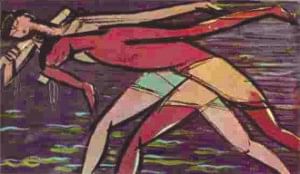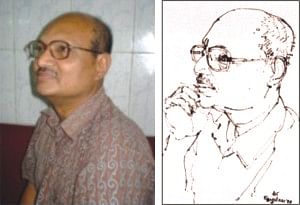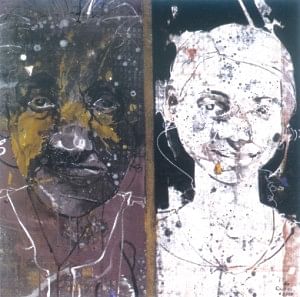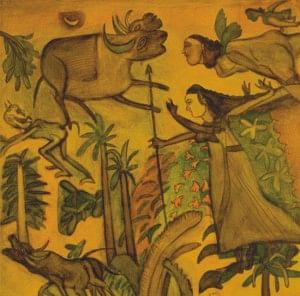|
Interview
Of Sweat, Blood, and Toil
FAYZA HAQ
 |
Zainul Abedin, Pulling |
Ranjit Das has had innumerable exhibits both at home and overseas and is also said to have one of biggest sales, here in Dhaka. Despite the distance from the hub of the city, he recently had a splendid show at Kaya Galley, which drew a sea of art enthusiasts .
It hasn't been easy for Ranjit Das to have pirouetted to the top. It has been a long, hard struggle. Knowing him for decades, when one shared patties and tea at his home, he is known to get used to strife from the outset. It hasn't been easy since he left his home in Old Dhaka and sketched and painted his heart out, to get self-satisfaction, and not just earn enough for his family.
Talented and driven, he has put in his imagination, memory, education and inspiration, to “load and bless” his canvases and drawing paper. His figures and backgrounds remain nonpareil for middle – years' artist. Educated enough, he remains self-effusive and soft-spoken. There are no bombast or ambitious declaration in this man with glasses, fast-fading hair on his pate, and pencil moustache.
Has your success and life been a bowl of cherries?
I believe that without struggle, one cannot be successful. Every man, who is anyone worth nothing, has had to practice and be correctly guided. He has to give a lot of his work; combine thought with understanding. I have gone through many books, done endless sketching, studied master painters – like Matisse, Picasso, Zainul Abedin, K G Subramanyan and M F Hussain . Having studied at the M S University Baroda, India, my main guide and inspiration were K G Subramanyan and K G Bhatt. I did my Masters from India in 1981 before returning home. My bachelor's degree was done from the then Arts College, Dhaka.
Your subjects include, faces (oil and mixed media) and landscapes (water-colour). Some of your works combine both. Others represent dreams and nightmares or premonitions. One has seen your exhibitions since 1981 at “La Gallery”(Banani), in “The Bengal Gallery” one found just faces , seen in different moods and time. Which work gave mot satisfaction?
What I'm concerned with is man's endeavours and the struggle and strife involved in that: I depict simple lives, which I feel should be paid homage to. I wish to depict the beauty of simple things in life. This is what I've seen around me, in our society.
 |
L-R: Ranjit Das, Ronjit Das, Self Portrait, ink on paper. |
I like abstraction: But I feel within abstraction I cannot convey my message satisfactorily. I have to keep in mind both the rural and urban scenes and subjects. The village environment and the lives of the villagers inspire me most of all. I study the lifestyle of the untouched and innocent – and then work on that. I must put passion in my work. I cannot paint what I don't feel. My message must contain the rhythm of my heart. It should contain a prior concept too. I don't wish to rush on in a harum-scarum manner, and slap on ideas and thoughts. I want to deliberate before I put on the paints.
I was born in Old Dhaka. I've been to my village home in Tangail. I spent the majority of the time in the city, having studied in Pogose School in the beginning. In Old Dhaka there are elements as in the villages such the rearing of horses, cows, apart from pigeons and ducks. We have monkeys around us all the time. I had dogs and pigeons in my youth, even though I got scolded for that. I am sometimes asked why I paint horse. I loved my horse riding days, and can never forget the rides in the horse-driven carriages of Old Dhaka.
I enjoy comparing what I've seen in India and Germany. The Far Eastern places were mind-boggling too – I mean places China, Singapore and Thailand. I have enjoyed seeing works of old masters, like those of Leonardo Da Vinci, Raphael, Rembrandt, Renoir, Van Gough. Who doesn't love Van Gough, Pissarro, and Picasso? I've had the opportunity for that too. Santiniketan and Bombay in India have their own fascination for lovers of experiences and scenes connected with art. I have enjoyed exchanging ideas with art lovers and the common man on the road there.
Who were the teachers, who guided, inspired and influenced you at the outset?
The teacher whom I admired most here in Dhaka was Safiuddin Ahmed. Mohammed Kibria also advised me, although I was not his direct student. Murtaja Baseer, Rashid Chowdury, Aminul Islam and I have discussed ideas and techniques outside the set academic hours. Of course, the European Renaissance Masters, like Leonardo Da Vinci, Raphael and Titian have inspired me no end. The light and shadow play in Goya has always fascinated me. I keep in mind geometrical details in my forms and figures. I use realism in my own way, adding modern perspective and presentation. It is for the viewers to decide how successful I've been. To me this is my challenge and my drive. I've studied many modern paintings, whether they be European or Indian or Bangladeshi. I've tried to combine the old classics with the modern techniques and styles. What is unknown and unacceptable gets difficult for the average viewer to comprehend. This may appeal to me and not the others. When artists moved on to Impressionism from Realism, this was not accepted by all at that time. For most artists, even today, life is not a bed of roses. It's often been an uphill struggle. What was done fifty years ago in Europe and the US has been repeated ad lib in Bangladesh and the rest of the subcontinent and even in the Far East. Surrealism, Dadaism, Pop Art, Op Art, and lately, the presentation of human private parts for shock techniques have intrigued viewers over the years. David Hokney, Andy Warhole and others are being copied and adapted by the young generations. But which way are we headed? There are many critiques to decide that. What I feel is that we should not lose sight of our own cultural roots.
 |
 |
Ronjit Das, Image and Reflections-11. |
K G Subramanyan, Goddess at Goalpara. |
How do you go about your work, at a time, or in bits and pieces? In other words, do you apply your paints and brushes on many canvases at a time, or deal with each painting singly? In a sense do you bring your ambiance, nostalgia, memories and paint at one go? You bring in music – as you yourself are a reputed singer – and you do not leave out cups of tea in between.
When I paint, I'm under a certain sense of pressure. At first, I worked at will, taking my time. Now, sometimes I work on six or seven canvases at one go. This is not what I want. This is a must.
Copyright
(R) thedailystar.net 2010 |
| |
